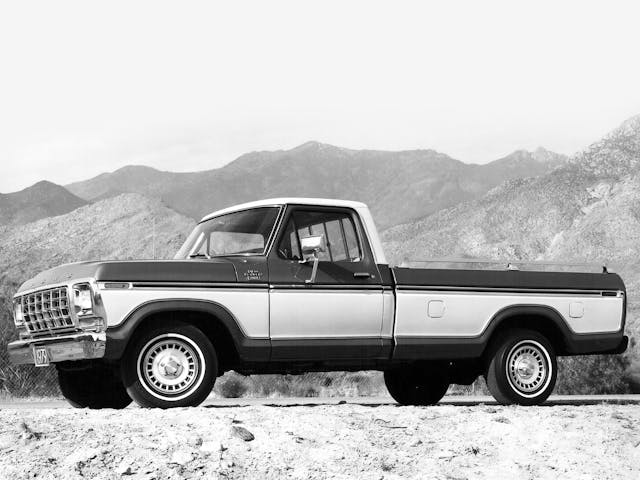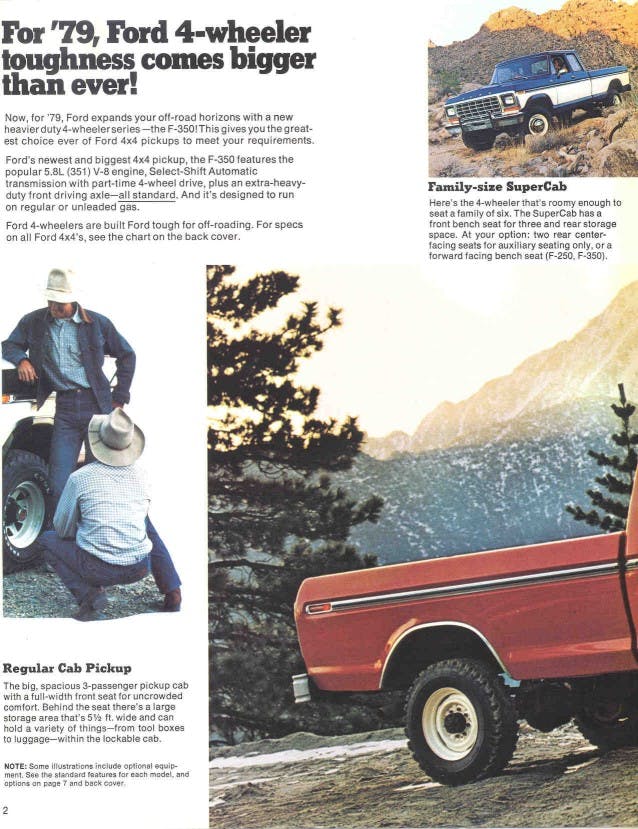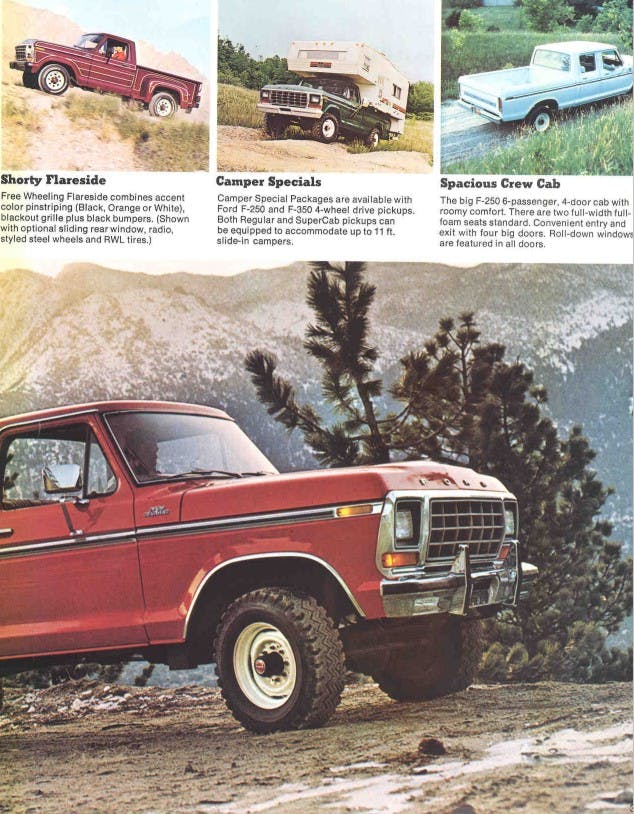Ford’s ’73–79 F-Series just won’t quit
Ford has no shortage of nameplates that get enthusiasts going. Mustang and GT40 are the obvious standouts, while the utilitarian Bronco is not far behind. That said, there’s another, more workaday model that’s captured our attention and is lighting up the value charts: Ford’s venerable sixth-generation F-Series.
In 1977, these trucks grabbed the pickup sales mantle for Ford, and the F-Series hasn’t looked back since. (Coming from a GM family, I’m obliged to point out there have been more than a couple years during that period when sales of the GMC and Chevy twins have together beaten those of the cross-town Ford; the Blue Oval only “wins” because GM’s trucks are technically two different models. But I digress.) Taking a conservative approach by using much of the same underpinnings as the previous generation, these “Dentside” Fords—so named for the indentation running the length of the body—were nonetheless a smash hit and rounded out the Ford truck hierarchy as we now know it.

Additional bed options (and a longer wheelbase) for the workhorse F-350 model were available from the generation’s debut in 1973, and the now-ubiquitous F-150 debuted in 1975. Trim levels changed over the course of the seven-year model run but included Custom, Ranger, Ranger XLT, and Ranger Lariat. The Lariat was about as decked-out as you could option a pickup then, with two-tone paint and a plush interior. As you can see from the brochure below, a variety of cabs, bed lengths, and bed styles met a broad swath of consumer needs.
Ford put an array of engines under Dentside hoods over the course of its seven-year production run: 240- and 300-cubic-inch sixes plus 302-, 351-, 360-, 390-, 400-, and 460-cubic-inch V-8s gave buyers plenty to choose from. For those who are shopping for these trucks today, engine differences make for slight variations in valuation, but while a 460 gets you bragging rights, there are worse things than tooling around with a 302 or a bulletproof Ford six-cylinder.
The exterior of these rigs benefited from extensive use of galvanized steel and rust-resistant coatings. Ford updated the Dentside F-Series’ look with mild tweaks to the grille in 1976 and again in 1978—this, along with the constant updating of engine and trim levels, helped keep the platform feeling fresh, even though it dated back to 1965.
Ford’s cover-all-bases approach (covered in great detail in our recent buyer’s guide on the Dentside) was a success then, and the truck is seeing renewed popularity now. That’s not just a generalized, pandemic-era-raised-all-prices statement, either—the sixth-gen F-Series is actually ticking up in value as the market has begun to come back down.
The rise of SUVs and old pickups as collector vehicles is nothing new, and Ford’s original Bronco was among the first to see values jump. As six-figure prices for Bronco or FJ40 Toyota Land Cruisers got people used to the idea that ’60s and ’70s collectibles weren’t limited to muscle and sports cars, values slowly began to rise for that era’s pickups as well.
Fast forward to now. Though the early darlings of the collector truck movement have lost some steam (#2-quality, Excellent condition first-gen Broncos are down 13 percent for the original Bronco in the last year, and FJ40 values are down just under ten percent), a similar condition F-150 4×4 with a 351-cubic inch engine is up 20 percent over the same period. The same F-150 in #3 condition is up nearly four percent.

The Dentside fares well against its contemporaries, too. Equivalent Dodge W- and D150 models (which are near to my heart after helping my cousin restore his—check out that story here) have been flat over the last year, and can be had for ten to twenty grand less depending on condition. Chevy’s K10 half-ton tracks the Ford more closely—it’s up nine percent for #2 and #3 conditions, though it’s still thousands cheaper than the Dentside.
The F-Series benefits from a very healthy set of buyer demographics. Younger buyers represent a full 40 percent of the market, while Gen X and baby boomers retain healthy shares as well. These trucks are nearly universally appreciated, and that pattern suggests they’ll continue to have a positive valuation outlook.
Are there more affordable classic trucks out there? Yes, there are. But if you love the ’73–79 F-Series’s looks and are good with a driver-quality example (you are going to use your classic truck as a truck, right?), you can still find decent examples in the teens. Besides, given how well-liked they appear to be across all ages, you’re likely to get out what you put into it. That’s the value of a good name.

***
Check out the Hagerty Media homepage so you don’t miss a single story, or better yet, bookmark it. To get our best stories delivered right to your inbox, subscribe to our newsletters.





Yes they sold a lot of them but the Galvanized steel did little to help preserve them. These rusted out just as much as most of the earlier models.
The worst part was the twin I beam suspensions. These ate tires and really were difficult to a line. Many owners would also let the kink pins freeze up and leave us with a mess to try to free them up,
There are many reasons the Square body Chevys of this era are much easier to find and restore.
Fords were cheaper to buy and that is how they won the sales. But in the end you paid for the savings.
Even today for lives on fleet sales and that is where the big number comes from.
Here in the rust-belt Midwest the squarebodies were perforated, rockers first, then cab corners, with 4-5 years of purchase. Dentsides took much longer although within 10 years they were both in trouble. Squareside rear cab mounts would collapse, leaving the back of the cab sagging against the bed. Front ends on the Squarebodies but there was plenty of money to be made in replacing the ball joints and upper control arm bushings, neither of which could be blamed on owner neglect like the frozen king pins would be on the Fords.
Not really a fan of either but really soured by my experiences with squarebodies.
I drove a company 1980 ford 150 for work in the vegetable/agriculture business for around 6 years. This truck had a 300 six with four speed stick in it. went thru powder dirt, sand, mud from the fields, the pickup never whimpered! Our fleet was all fords between 1976, to 1986 with the 300s and four speeds. I put over 200,000 miles on mine with regular maintenance (especially changing out the air filters because of the environment it was in). The ONLY thing that went out was I blew out half of the spyder gears out trying to pull out a 2 1/2 ton truck out of the mud in the field, and it still got me in to the shop! All of our fleet took a great deal of farm abuse but were definitely good dependable trucks. As long as you didn’t try to pull stunts like I did!my next truck again was a 1986 Ford 1/2 ton still the same dependability for more than four years. Those 300 six’s were a good work horse for sure.
I’m slightly surprised at some of the data interpretation (or perhaps I read it wrong). The “thousands cheaper than the dentside” line about the squarebody 4×4 makes me wonder a few things:
Are the smaller population of mostly really nice dentsides skewing the data? With these trucks it is either someone’s treasure or a parts truck with minimal in between. Squarebodies we still have a few people in the city I live using them as work trucks…
67-72 C10 rule the market where I live by a huge margin. Really nice trucks the 64-66 C10 seem to eclipse their 60-63 generation mates and squarebody is right there. 90s Dodges with Cummins engines and dentsides are probably next with GMT400 there in some cases (dirt cheap still in others). Other eras of Fords are a tier down and just about any Dodge is cheaper. For project quality the orphans (international, Studebaker) are cheap when they come up but that isn’t often.
Not surprised 4×4 rules dentside though, Bigfoot was born a dentside right? And the dentside Bronco is peak Bronco looks wise to me (and others).
My father has ended up with a collection of nearly every year of dentside ranging from 77 camper special, 79 F350, a 75 dump box F350 and even an unrestored 76 F100. Basically none of the best investments!
They are cool trucks. Beware the front body mounts rotting out, causing the cab to sag and pinch on the steering column causing really strange symptoms. Parts availability of these has exploded in the last 10 years. The car mags will have you believe you have to Crown Vic clip swap them (which can be nice) but it depends what you want to do with it. My dad’s 77 F250 rides smooth with stock suspension. The 74 F350 with Lincoln 429 swap (don’t ask) rides like a Sherman Tank.
They still exist around Texas. Not quite my thing but they are out there.
I had a 1976 with a 300 straight six and 4 speed stick that was really a 3 speed. It had a low, low gear like bread box truck. The pickup was indestructible until the body rusted out. Never a problem but only had a radio, heater and power steering. The six was very powerful and smooth. It glided along in 4th gear.
In 1988 I decided to build a house and the first tool I needed was a truck, so I picked out my favorite looking one, the dentsides. I ended up with a 79 F150 with a 351 automatic and it has been bulletproof. Floor is rusty from vent window leaks and rubber floor mats (no carpet). The C6 leaks a little and when it starts dropping out of gear I add fluid and it’s happy. I wish that I could shelter it so that it would not deteriorate as much, but it’s a great truck.
Had a 73 3/4 ton with a 360 engine. Pulled my fifth wheel easy. My only gripes were the 16 1/2” wheels and constantly putting brake pads on the front. It was oil sprayed and rust was never a problem even though I live where they salt the roads in winter.
I love them. I’ve had a 73,74,76and currently a 79 F350 dually. I love the twin I beam 2WD suspensions. Never had a problem. Stick to the road. As far as rust what truck didn’t? At least where Iam at. The galvanized parts where the only parts left on most of them. Ford will always be King when It comes to trucks.
Bryant
I have a 94 short box, so 20 years newer than the story is concentrated on. Just yesterday I put 700 miles on the 300 straight six, it never missed a beat. And, that was pulling a loaded trailer for half the distance.
I have a “ragdoll.” In the culture of my Southern Boy youth, that’s what we called a vehicle that still served us well – but showed the ravages of time. My ’73 has two (three?) rust throughs. A 302 and C-4. Never had trouble with that twin front axle. I put a power steering in it – that was a challenge – over sensitive as most power steering was in that era. Love the big bed. It’s a work truck – not a show queen.
Ford had a winner with the 300 six. Try and find a Chevy with a 292?
I’m a Ford guy these days, since I’ve somehow wound up with 5 Ford trucks at my house. But I have 2 Chevys, one with an inline 230 and the other with a 235. I did have a 1971 P30 up until about a year or so ago, that had single rear 19.5 wheels, with the 292 and a 4 speed. That was a neat combo and if I hadn’t been made a good offer on the whole truck I would’ve kept the 292 to replace the 235 in my 1951 Chevy 4100. I’m partial to an inline, whether it be a Ford, Chevy, Jeep, or even the slant six.
I have 4 Fords with the twin I-beam, and one of those is 4wd. I don’t mind the twin I-beam suspesions. In MS, these trucks aren’t anymore rusted out, maybe even less rusted out, than the GMs of the same time period. The ones I own have been outside their whole lives, and only the 86 4wd is showing a little rust in the front of the bed where it must have sat with leaves and dirt there for a long time before I bought it. The Ford’s hood don’t kink like the GMs in similar condition. I hate seeing a kinked hood. I’ve got the 300, 302, and the 351, with manual and auto transmissions, and I enjoy them all. They’re not show winners but they’re fun drivers.
I’m still rocking my 77’ F150 custom, explorer edition, with a 351…..Love it!
I noticed the other day that a pair of trucks sitting in a neighbor’s back yard (one a dentside, the other a bumpside) have disappeared. Been stored there for years. Perhaps the owner took advantage of the roughly 20% increase in price that these would supposedly bring? 😋
I have a 1976 with 302. Blue metallic inside and out. Came with explorer striping, which had box rails, special wheel covers, polished aluminum mirrors, and hood ornament with EXPLORER ON IT. I bought this truck new, took advantage of the ECP ( extended corrosion protection ) the dealer offered for $90.00 . Best $90.00 I ever spent. There is and has never been any rust on this truck. It has a little over 100,000 miles, and is as clean as the day I bought it.
Holy cow I have a ’74 that I use every three weeks to buy hay and grain, etc. I had it completely restored. I had no idea the values were up this much.